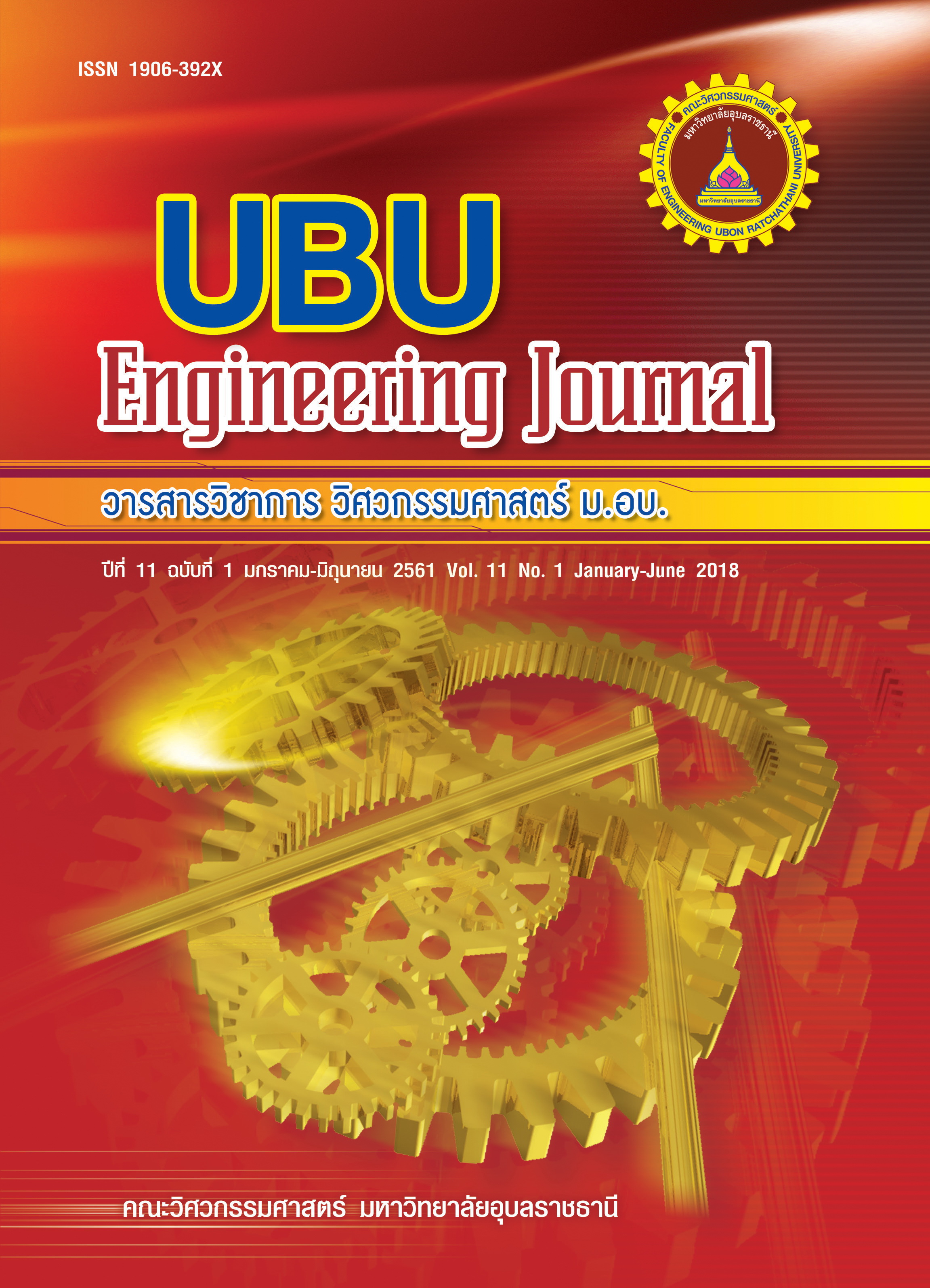การปรับปรุงสมรรถนะของเตาแก๊สหุงต้มเชื้อเพลิงแก๊สชีวภาพ
Main Article Content
Abstract
The main objective of this research presents about the investigation of performance of a biogas fueled cooking burner. The present paper has suggested performance improvement through different designs modifications in the fuel injection nozzle, mixing tube and burner cap. The fuel injection nozzles and throat diameters were varied from 0.8 to 1.3 mm and 17 to 24 mm, respectively. Moreover, the burner port has been modified as a swirling flame. The DIN EN 203-2 standard was applied to performance burner test. The effect of fuel injection nozzles and throat diameters on combustion performance such as thermal efficiency and emission was studied. The results show that the optimum injection nozzle and throat diameter was observed at 1.2 and 20 mm, respectively, due to the obtained maximum thermal efficiency and also emits lowest concentration of carbon monoxide (CO). Additionally, the swirl flow burner (SB) yields higher thermal efficiency and emits only slightly higher CO concentration than those of the conventional radial flow burner (RB). However, the CO emission is also lower than the value specified by the considered emissions standard (1,500 ppm at 0% excess O2).
Article Details
References
[2] วสันต์ โยคเสนะกุล. หัวเผาเชื้อเพลิงแก๊สที่มีการหมุนเวียนความร้อนและการไหลแบบหมุนวน. วิทยานิพนธ์หลักสูตรปริญญาวิศวกรรมศาสตรมหาบัณฑิตสาขาวิชาวิศวกรรมเครื่องกล คณะวิศวกรรมศาสตร์ มหาวิทยาลัยเทคโนโลยีพระจอมเกล้าธนบุรี. 2547.
[3] Weinberg, FJ. Heat-recirculating burners. principles and some recent developments. Combustion Science and Technology. 1986; 121: 3−22.
[4] Yoshizawa Y. Echigo R, Tomimura T. A study on a high performance radiant heater. In: Proceedings of the 2nd ASME/JSME Thermal Engineering Joint Conference; 1987. p. 317−323.
[5] ณัฐวุฒิ รังสิมันตุชาติ. การประยุกต์ใช้วัสดุพรุนเพื่อการประหยัดพลังงานในเตาแก๊สหุงต้ม. วิทยานิพนธ์หลักสูตรปริญญาวิศวกรรมศาสตรมหาบัณฑิตสาขาวิชาวิศวกรรมเครื่องกล คณะวิศวกรรมศาสตร์ มหาวิทยาลัยเทคโนโลยีพระจอมเกล้าธนบุรี. 2544.
[6] Jugjai S, Rungsimuntuchart N. High efficiency heat recirculating domestic gas burners. Experimental Thermal and Fluid Science. 2002; 26: 581–592.
[7] Pantangi VK, et al. Studies on porous radiant burners for LPG (Liquefied Petroleum Gas) cooking applications. Energy. 2011; 36: 1–7.
[8] Muthukumar P, Shyamkumar PI. Development of novel porous radiant burners for LPG cooking applications. Fuel. 2011; 112: 562–566.
[9] Shtern V, Borissov A, Hussain F. Temperature distribution in swirling jets. International Journal of Heat and Mass Transfer. 1998; 41: 2455−2467.
[10] Tamir A, Elperin T, Yotzer S. Performance characteristics of a gas burner with a swirling central flame. Energy. 1989; 14: 373−382.
[11] Tamir A. A swirling-flame combustor for lean mixtures. Combustion Science and Technology. 1993; 90: 193−209.
[12] Hou SS, Ko YC. Influence of oblique angle and heating height on flame structure, temperature field and efficiency of an impinging laminar jet flame. Energy Conversion and Management. 2005; 46: 941−958.
[13] Gupta AK, Lilley DG, Syred N. Swirl flows. Taylor & Francis; 1984.
[14] Tamir A, Elperin I, Yotzer S. Performance characteristics of a gas burner with a swirl central flame. Energy. 1992; 14: 347−362.
[15] Saha C, Ganguly R, Datta A. Heat transfer and emission characteristics of impinging rich methane and ethylene jet flames. Experimental Heat Transfer. 2008; 21: 169−187.
[16] Chander S, Ray A. Flame impingement heat transfer: a review. Energy Conversion and Management. 2005; 46: 2803−2837.
[17] Kurchania AK, Panwar NL, Pagar SD. Development of domestic biogas stove. Biomass Conversion and Biorefinery. 2011; 1: 99−103.
[18] Mahin D.B. Biogas in developing countries, Bioenergy system report to USAID, Washington D.C. 1992.
[19] Chan US. State of the art review on the integrated use of anaerobic processes in China. Internal report prepared for IRCWD. 1982.
[20] Dutt GS, Ravindranath NH. Distribution of tree species on different sized farms in a semi-arid village, Farm forestry in South Asia, Sage Publications, India. 1993.
[21] Burbano HJ, Amell AA, Garcıa JM. Effects of hydrogen addition to methane on the flame structure and CO emissions in atmospheric burners. International Journal of Hydrogen Energy. 2008; 33: 3410−3415.
[22] Jadhav P, Sudhakar DS. Analysis of burner for biogas by computational fluid dynamics and optimization of design by genetic algorithm. International Journal for Research in Emerging Science and Technology. 2015; 2: 39−44.
[23] อภินันต์ นามเขต, สำเริง จักรใจ. คุณลักษณะการเหนี่ยวนำอากาศส่วนแรกของหัวเผาแบบ Self – aspirating. ใน: การประชุมวิชาการเครือข่ายวิศวกรรมเครื่องกลแห่งประเทศไทยครั้งที่ 21, ชลบุรี, ประเทศไทย, 17-19 ตุลาคม; 2550.
[24] German Standards and Technical Rules. Gas-heated Catering Equipment. 1997; 203(2): 17 pages.
[25] อนุชา กล่ำน้อย, บัณฑิต กฤตาคม. การประยุกต์ใช้วิธีการถดถอยแบบเส้นตรงเชิงพหุสำหรับทำนายปริมาณ NOx จากการเผาไหม้เชื้อเพลิงแก๊สของหัวพ่นไฟวัสดุพรุนแบบเม็ดกลมอัดแน่น. วารสารวิชาการ วิศวกรรมศาสตร์ ม.อบ. 2559; 9(1): 31−38.

